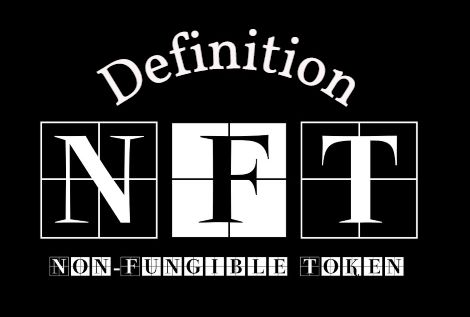NFT – definition. When we talk about NFT, what exactly are we talking about? Here’s a complete definition.
NFT – definition, why bother? In fact, understanding what an NFT is and isn’t is becoming increasingly important, as they take on an ever-greater role in our lives.
NFT – brief description:
An NFT (non-fungible token) – in French: « jeton non fongible« , is a unique digital object tracked, stored, and authenticated through a blockchain protocol.
Each NFT is associated with a digital identifier, making it non-fungible (i.e., not interchangeable with other tokens).
These tokens grant rights—such as ownership—over real or virtual objects, including digital art, contracts, diplomas, and more.
Unlike cryptocurrencies like Bitcoin, which are fungible, NFTs derive their value from their uniqueness and symbolic significance.
Typically, NFTs are generated using smart contracts on the Ethereum blockchain, often following the ERC-721 standard.
NFT – definition:
An NFT, or Non-Fungible Token, is a unique digital asset that represents ownership or proof of authenticity of a specific item or piece of content, typically using blockchain technology. Unlike cryptocurrencies such as Bitcoin or Ethereum, which are fungible and can be exchanged on a one-to-one basis, NFTs are distinct and cannot be exchanged on an equal basis because each NFT has unique properties and identifiers.
Key characteristics of NFTs include:
- Uniqueness: Each NFT has a distinct identifier that distinguishes it from other tokens.
- Ownership: NFTs provide verifiable proof of ownership recorded on the blockchain.
- Indivisibility: NFTs cannot be divided into smaller units; they exist as whole items.
- Interoperability: NFTs can be used across different platforms and marketplaces, thanks to standard protocols such as ERC-721 and ERC-1155.
NFTs can represent a wide range of digital items, including:
- Artworks
- Music and audio files
- Videos and animations
- In-game items and virtual real estate
- Collectibles and memorabilia
The use of NFTs has surged in popularity due to their ability to monetize and provide a market for digital content creators, while also giving collectors a way to own and trade unique digital assets.
NFT, how it works?
NFTs (non-fungible tokens) work on the basis of blockchain technology, which enables the creation, verification and transfer of unique, non-interchangeable digital assets. Here’s an overview of how they work:
Creating an NFT
Minting: Creating an NFT, known as “minting”, involves converting a digital file (such as an image, video, music, etc.) into a unique token on a blockchain. This is done via dedicated platforms, such as OpenSea, Rarible, or Foundation.
Metadata: During minting, specific metadata is added to the NFT, including information such as name, description, and unique attributes. This metadata is stored on the blockchain, guaranteeing its immutability and verifiability.
How it works on the blockchain?
Blockchain: NFTs are generally created and managed on smart contract-compatible blockchains, such as Ethereum, Binance Smart Chain, and Flow. ERC-721 on Ethereum is commonly used for NFTs, as well as ERC-1155 for semi-fungible tokens. NFTs therefore use the blockchain to offer unique digital ownership certificates, enabling a new form of ownership and commerce in the digital world.
Smart contracts: Smart contracts are self-executing programs on the blockchain that manage the creation, transfer and interaction with NFTs. They ensure that the rules defined when the NFT was created are respected.
NFT and tokenization:
Tokenization is the process of converting physical or digital assets into tokens on a blockchain. NFTs (non-fungible tokens) represent a specific form of tokenization, focusing on the creation of unique, indivisible tokens, which makes them distinct from fungible tokens such as cryptocurrencies. Here’s how tokenization and NFTs fit together and complement each other.
Tokenization
Definition and Functioning :
Tokenization of physical assets: This involves the creation of tokens that represent physical assets such as real estate, art or collectibles. Each token is a digital representation of the underlying asset.
Tokenization of digital assets: This involves the creation of tokens for purely digital assets, such as digital artworks, videos, music, etc.
Process :
Asset identification: Select the asset to be tokenized, whether physical or digital.
Token creation: Use a blockchain platform to create a token representing the asset. For digital assets, this process is often called “minting”.
Registration on the blockchain: The token and its metadata (asset information, owner, transaction history) are registered on the blockchain.
Issuance and distribution: Tokens can be issued and distributed via sales platforms, auctions or direct exchanges.
NFTs and tokenization
Characteristics of NFTs :
Specificity: Each NFT is unique, thanks to its specific identifiers and metadata.
Non-fungibility: Unlike fungible tokens such as cryptocurrencies (Bitcoin, Ethereum), NFTs cannot be exchanged on an equal basis, as each NFT has distinct characteristics.
Proof of ownership: NFTs offer verifiable proof of ownership and authenticity on the blockchain.
Indivisibility: NFTs cannot be divided into smaller units; they exist as complete entities.
Applications of NFTs:
Digital art: Artists create digital artworks in the form of NFTs, making it possible to sell and buy these works verifiably and securely.
Music and media: Musicians and content creators can sell limited or exclusive versions of their works in NFT form.
Video games: Game objects, characters and virtual terrain can be tokenized as NFTs, enabling players to own and trade these items.
Virtual real estate: Virtual reality platforms such as Decentraland or The Sandbox allow virtual land to be bought and sold in the form of NFT.
Advantages of tokenization via NFT
Transparency: The blockchain offers total transparency of transactions and ownership histories.
Security: The decentralized nature of the blockchain ensures the security and immutability of records.
Liquidity: Tokenized assets can be traded more easily on secondary markets, increasing their liquidity.
Accessibility: Assets can be divided into smaller shares (in the form of fungible tokens for certain assets), enabling a greater number of people to invest.Conclusion
Tokenization via NFTs is transforming the way assets are created, exchanged and owned, offering new opportunities in diverse sectors such as art, entertainment and real estate. NFTs add a layer of verifiability and security, making digital assets unique and valuable in the emerging digital economy.
Summed up in one sentence, the definition of an NFT is as follows: an NFT (non-fungible token) is a unique and indivisible digital asset, representing the ownership or authenticity of a specific object or content, securely stored on a blockchain.


4 commentaires sur « NFT – definition »
Les commentaires sont fermés.